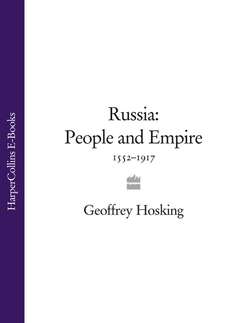Russia: People and Empire: 1552–1917

Реклама. ООО «ЛитРес», ИНН: 7719571260.
Оглавление
Geoffrey Hosking. Russia: People and Empire: 1552–1917
Contents
MAPS
Introduction
The Russian Empire: How and Why? A. The Theory of Empire
B. The Practice of Empire
C. Russia as empire – conclusions57
1 The First Crises of Empire
Time of Troubles
The Church Schism
2 The Secular State of Peter the Great
3 Assimilating Peter’s Heritage
4 The Apogee of the Secular State
1 The Nobility
2 The Army
3 The Peasantry
4 The Orthodox Church
5 Towns and the Missing Bourgeoisie
6 The Birth of the Intelligentsia
7 Literature as ‘Nation-Builder’
1 The Reforms of Alexander II
2 Russian Socialism
3 Russification
4 The Revolution of 1905–7
5 The Duma Monarchy
6 The Revolution of
Conclusions
Afterthoughts on the Soviet Experience
Chronology. Ivan IV 1533–1584
Fedor I 1584–1598
Boris Godunov 1598–1605. Time of Troubles 1604–1613
Mikhail Fedorovich 1613–1645
Aleksei Mikhailovich 1645–1676
Fedor Alekseevich 1676–1682. Peter I 1682–1725 (Until 1696 jointly with Ivan V)
Catherine I 1725–1727
Peter II 1727–1730. Anna 1730–1740. Ivan VI 1740–1741. Elizabeth 1741–1761
Peter III 1761–1762
Catherine II 1762–1796
Paul I 1796–1801. Alexander I 1801–1825
Nicholas I 1825–1855
Alexander II 1855–1881
Alexander III 1881–1894
Nicholas II 1894–1917
Notes. Introduction
PART ONE The Russian Empire: How and Why?
PART TWO State-Building. 1 The First Crises of Empire
2 The Secular State of Peter the Great
3 Assimilating Peter’s Heritage
4 The Apogee of the Secular State
PART THREE Social classes, religion and culture in Imperial Russia. 1 The Nobility
2 The Army
3 The Peasantry
4 The Orthodox Church
5 Towns and the Missing Bourgeoisie
6 The Birth of the Intelligentsia
7 Literature as ‘Nation Builder’
PART FOUR Imperial Russia under pressure. 1 The Reforms of Alexander II
2 Russian Socialism
3 Russification
4 The Revolution of 1905–7
5 The Duma Monarchy
6 The Revolution of 1917
Conclusions
Index
Acknowledgements
About the Author
ALSO BY GEOFFREY HOSKING
RUSSIA PEOPLE AND EMPIRE
Copyright
About the Publisher
Отрывок из книги
GEOFFREY HOSKING
RUSSIA
.....
Ghazi’s successor, the Imam Shamil’, led the resistance movement for quarter of a century (1834–59), exploiting all the advantages the terrain afforded him. Small bands of lightly armed men could descend at any moment on a Russian outpost or convoy, exploiting surprise and mobility to inflict the maximum damage and loss of life, before vanishing into the mountains and forests. This was a kind of warfare to which the Russians, with their long experience of the steppes, were not at all accustomed, and it was very difficult for them, despite their considerable superiority in numbers and technology, to overcome their nimble foe. Deploying more troops simply generated more casualties. The Russians’ attempts to divide their opponents and gain allies would call forth swift and ferocious retaliation from Shamil’.28
The Crimean War (1853–6) revealed what a threat this endless Caucasian fighting could be to the empire: two hundred thousand troops had to be stationed there throughout the war to keep an eye on both Shamil” and the Turks and were thus unable to intervene in the decisive theatre of war. In the end only a systematic campaign of forest-felling, crop-burning, road-building and destruction of villages enabled the Russians to gain a permanent grip on the Caucasus range.29
.....